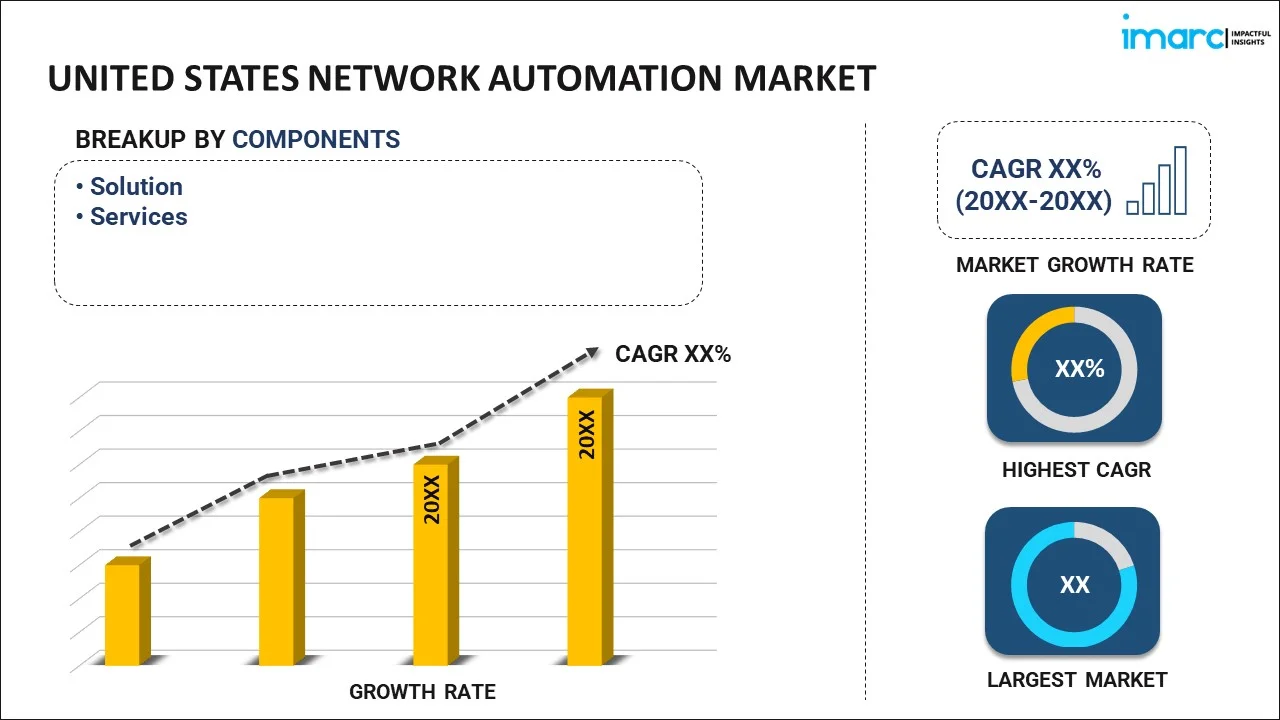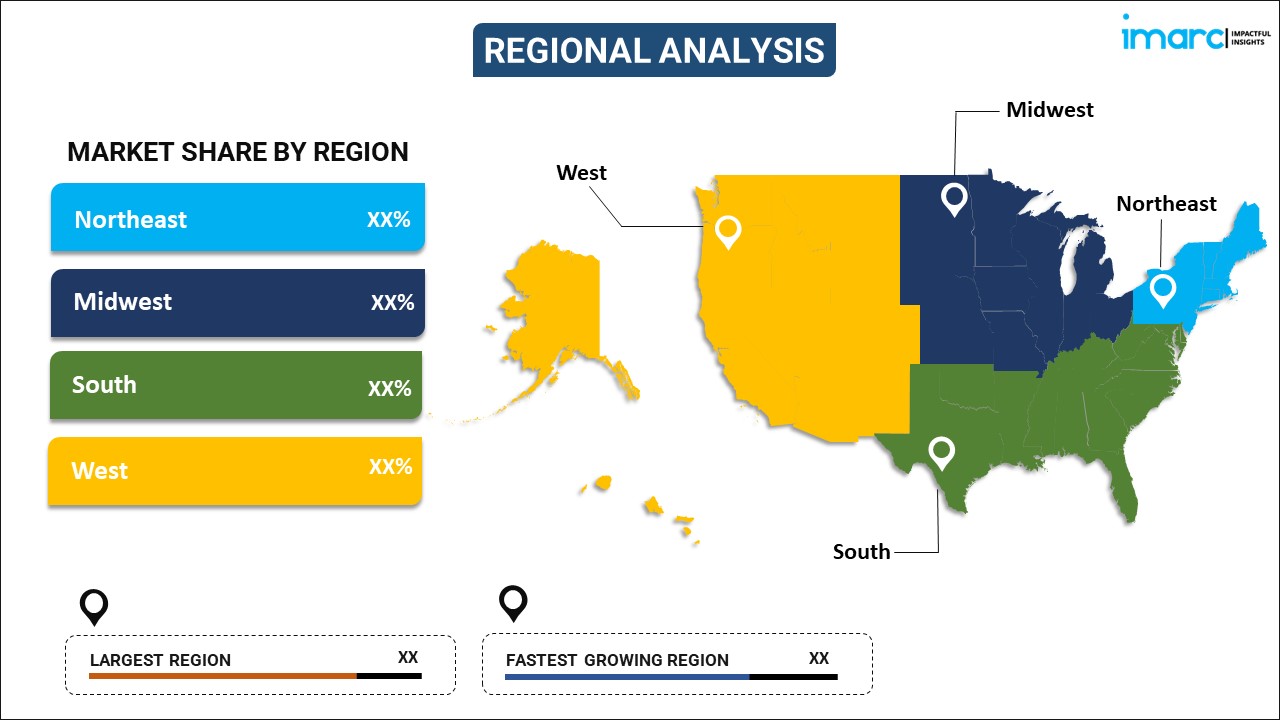
United States Network Automation Market Report by Component (Solution, Services), Deployment Mode (On-premises, Cloud-based), Organization Size (Large Enterprises, Small and Medium-sized Enterprises), Network Type (Physical, Virtual, Hybrid), End Use Industry (IT and Telecom, Manufacturing, Energy and Utility, Banking and Financial Services, Education, and Others), and Region 2025-2033
Market Overview:
United States network automation market size reached USD 2.5 Billion in 2024. Looking forward, IMARC Group expects the market to reach USD 17 Billion by 2033, exhibiting a growth rate (CAGR) of 23.7% during 2025-2033. The market is being driven by factors such as the growing complexity of networks, swift digital transformation, the incorporation of artificial intelligence (AI) and machine learning (ML) technologies, increasing adoption of intelligent connected devices, and the substantial growth in data usage.
|
Report Attribute
|
Key Statistics
|
|---|---|
|
Base Year
|
2024
|
|
Forecast Years
|
2025-2033
|
|
Historical Years
|
2019-2024
|
|
Market Size in 2024
|
USD 2.5 Billion |
|
Market Forecast in 2033
|
USD 17 Billion |
| Market Growth Rate 2025-2033 | 23.7% |
Network automation involves the automatic execution of network operations based on predefined instructions, minimizing the need for human intervention. Its components include configuration tools, application programming interfaces (APIs), testing, and analytics tools. Network automation finds application in various areas such as automated device discovery, network mapping, policy enforcement, event-driven automation, continuous compliance, performance management, security management, automated provisioning, disaster recovery, and traffic analysis. The benefits of network automation encompass improved network agility, reduction of human errors, enhanced network control, and increased accuracy in network tasks. Additionally, it contributes to cost savings, heightened network security, and faster resolution of network issues.
United States Network Automation Market Trends:
The United States network automation market is experiencing substantial growth driven by several influential factors. Additionally, the escalating complexity of networks, rapid digital transformation, integration of artificial intelligence (AI) and machine learning (ML) technologies, widespread adoption of smart connected devices, and the exponential surge in data usage are key contributors to the market's expansion. Besides this, network automation in the United States involves the seamless execution of network operations through predefined instructions, minimizing the need for human intervention. Furthermore, the market encompasses a range of components, including configuration tools, application programming interfaces (APIs), testing, and analytics tools. Apart from this, widely applied in automated device discovery, network mapping, policy enforcement, event-driven automation, continuous compliance, performance management, security management, automated provisioning, disaster recovery, and traffic analysis, network automation brings enhanced network agility, reduced human errors, and improved control and accuracy to network tasks. Furthermore, it plays a pivotal role in cost savings, bolstering network security, and expediting the resolution of network issues. As technology continues to advance, the United States network automation market is poised for sustained growth that will reflect its critical role in the dynamic landscape of modern network management over the forecasted period.
United States Network Automation Market Segmentation:
IMARC Group provides an analysis of the key trends in each segment of the market, along with forecasts at the country level for 2025-2033. Our report has categorized the market based on component, deployment mode, organization size, network type, and end use industry.
Component Insights:

- Solution
- Network Automation Tools
- SD-WAN and Network
- Virtualization
- Internet-Based Networking
- Services
- Professional Service
- Managed Service
The report has provided a detailed breakup and analysis of the market based on the component. This includes solution (network automation tools, SD-WAN and network, virtualization, and internet-based networking) and services (professional service and managed service).
Deployment Mode Insights:
- On-premises
- Cloud-based
A detailed breakup and analysis of the market based on the deployment mode have also been provided in the report. This includes on-premises and cloud-based.
Organization Size Insights:
- Large Enterprises
- Small and Medium-sized Enterprises
The report has provided a detailed breakup and analysis of the market based on the organization size. This includes large enterprises and small and medium-sized enterprises.
Network Type Insights:
- Physical
- Virtual
- Hybrid
A detailed breakup and analysis of the market based on the network type have also been provided in the report. This includes physical, virtual, and hybrid.
End Use Industry Insights:
- IT and Telecom
- Manufacturing
- Energy and Utility
- Banking and Financial Services
- Education
- Others
The report has provided a detailed breakup and analysis of the market based on the end use industry. This includes IT and telecom, manufacturing, energy and utility, banking and financial services, education, and others.
Regional Insights:

- Northeast
- Midwest
- South
- West
The report has also provided a comprehensive analysis of all the major regional markets, which include the Northeast, Midwest, South, and West.
Competitive Landscape:
The market research report has also provided a comprehensive analysis of the competitive landscape. Competitive analysis such as market structure, key player positioning, top winning strategies, competitive dashboard, and company evaluation quadrant has been covered in the report. Also, detailed profiles of all major companies have been provided.
United States Network Automation Market Report Coverage:
| Report Features | Details |
|---|---|
| Base Year of the Analysis | 2024 |
| Historical Period | 2019-2024 |
| Forecast Period | 2025-2033 |
| Units | Billion USD |
| Scope of the Report | Exploration of Historical Trends and Market Outlook, Industry Catalysts and Challenges, Segment-Wise Historical and Future Market Assessment:
|
| Components Covered |
|
| Deployment Modes Covered | On-premises, Cloud-based |
| Organization Sizes Covered | Large Enterprises, Small and Medium-sized Enterprises |
| Network Types Covered | Physical, Virtual, Hybrid |
| End Use Industries Covered | IT and Telecom, Manufacturing, Energy and Utility, Banking and Financial Services, Education, Others |
| Regions Covered | Northeast, Midwest, South, West |
| Customization Scope | 10% Free Customization |
| Post-Sale Analyst Support | 10-12 Weeks |
| Delivery Format | PDF and Excel through Email (We can also provide the editable version of the report in PPT/Word format on special request) |
Key Questions Answered in This Report:
- How has the United States network automation market performed so far and how will it perform in the coming years?
- What has been the impact of COVID-19 on the United States network automation market?
- What is the breakup of the United States network automation market on the basis of component?
- What is the breakup of the United States network automation market on the basis of deployment mode?
- What is the breakup of the United States network automation market on the basis of organization size?
- What is the breakup of the United States network automation market on the basis of network type?
- What is the breakup of the United States network automation market on the basis of end use industry?
- What are the various stages in the value chain of the United States network automation market?
- What are the key driving factors and challenges in the United States network automation?
- What is the structure of the United States network automation market and who are the key players?
- What is the degree of competition in the United States network automation market?
Key Benefits for Stakeholders:
- IMARC’s industry report offers a comprehensive quantitative analysis of various market segments, historical and current market trends, market forecasts, and dynamics of the United States network automation market from 2019-2033.
- The research report provides the latest information on the market drivers, challenges, and opportunities in the United States network automation market.
- Porter's five forces analysis assist stakeholders in assessing the impact of new entrants, competitive rivalry, supplier power, buyer power, and the threat of substitution. It helps stakeholders to analyze the level of competition within the United States network automation industry and its attractiveness.
- Competitive landscape allows stakeholders to understand their competitive environment and provides an insight into the current positions of key players in the market.
Need more help?
- Speak to our experienced analysts for insights on the current market scenarios.
- Include additional segments and countries to customize the report as per your requirement.
- Gain an unparalleled competitive advantage in your domain by understanding how to utilize the report and positively impacting your operations and revenue.
- For further assistance, please connect with our analysts.
 Inquire Before Buying
Inquire Before Buying
 Speak to an Analyst
Speak to an Analyst
 Request Brochure
Request Brochure
 Request Customization
Request Customization




.webp)




.webp)












